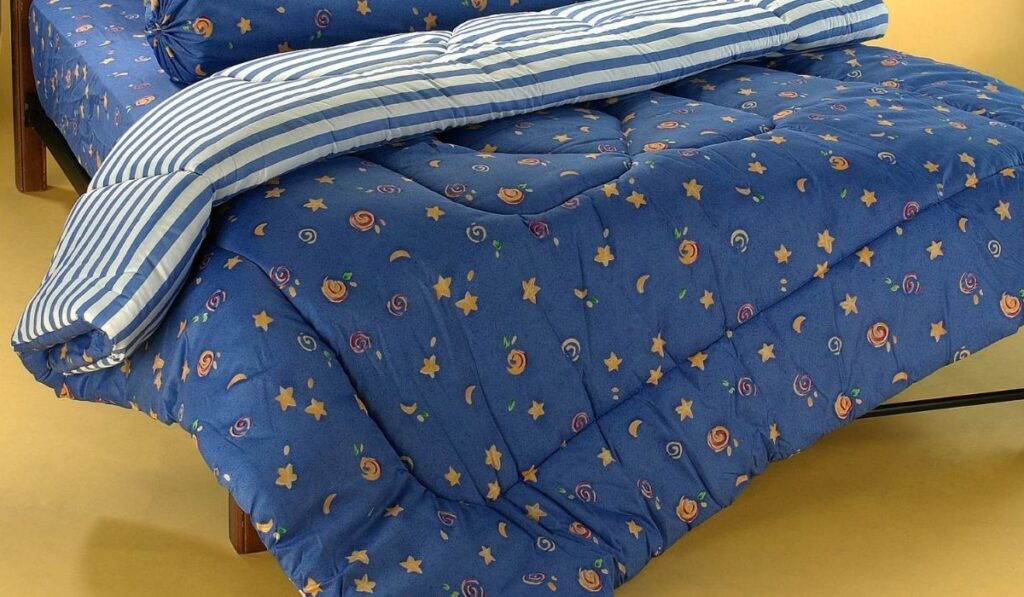Comforters made from cotton or cotton blends and filled with down feathers, polyester, or cotton batting will eventually wear out. They may be unfit for use due to damage and wear, or they may no longer be useful to you. But simply throwing old comforters away is not an ideal solution. So, what other options exist? Can you recycle a comforter?
Comforters and blankets are household textiles, meaning that you may be unable to recycle them using the standard curbside recycling system. Check for local recycling and donation options, or repurpose your comforters into cushions, quilts, cleaning rags, and other useful items.
Next time you’ve got an old comforter you want to get rid of, don’t head straight for a trash can. Instead, consider the many ways to reuse or recycle it. Let’s take a look at what comforters are made of, how long they last, and what you can do with your old ones, regardless of whether they’re too worn out to use anymore or if you’re just looking to upgrade to something new.
What Is a Comforter?

A comforter is generally a thick, fluffy, quilted blanket that helps you to keep warm at night. It is usually stuffed with synthetic fiber filler that is stitched or quilted to keep the filling secure and evenly distributed.
Compared to a duvet, a comforter forms only a single piece of bedding, while the duvet usually requires a cover. A comforter is designed to lay atop your sheets, and those who prefer a layered look may opt for this option.
Typically, comforters are sold as part of bedding sets with coordinated sheets to make decorating easy. Caring for your comforter is relatively easy since it can simply be added to the wash and other bedding. There are several kinds of comforters, some of which are described below:
Bamboo: Bamboo fibers make some modern comforters and are preferred for several reasons. Firstly, bamboo is a sustainable plant material that repels moisture naturally and is antibacterial and hypoallergenic. Sleepers who tend to sweat a lot may opt for the cooling properties of the bamboo bedding and its ability to absorb wetness.
Cotton: This versatile fabric is a favorite for making comforters. There are cotton percale blankets with a thread count of around 200 and high-end cotton comforters with thread counts of 600.
Cotton blankets are preferred among many sleepers because the material is well aerated, comfortable, easy to clean, and hypoallergenic. Comforters with a thinner profile are great for warm weather, but a thick and fluffy cotton comforter stuffed with down is more suitable for colder weather. Cotton comforters can be washed in the washing machine when necessary.
Down-filled: Typically stuffed with goose feathers, down-filled comforter types are the most classic option. Duck feathers are a less expensive choice, and they perform as well as goose down. Down-filled comforters are usually made of bamboo, cotton, or polyester. You can find luxury-quality down comforters with thread counts as high as 1,200 or higher, like this one (on Amazon) — or more standard options like 300 and 600.
Flannel: Flannel is a beautiful fabric ideal for homes with a country or rustic vibe. You may need a lint roller to get rid of fuzzies, but this kind of blanket can be washed in the washing machine.
Ensure that you dry the blanket at a low temperature and avoid washing it with other items. Flannel blankets have an average thread count of 300 and are suitable for cold weather. The blanket needs to be stain treated before you wash it and then tumble dry on the cool setting.
Polyester: Polyester is a synthetic fabric, making it cheaper than natural materials such as wool or silk. Polyester comforters are not as aerated as cotton but can trap heat well in cold weather without making you sweaty. You can easily find a durable and fluffy polyester comforter with a thread count of 200. Check out the Sweet Home Collection Polyester Comforter (on Amazon).
Microfiber: Microfiber is hypoallergenic, non-irritating, and feels fantastic on the skin. The material is made of very fine polyester strands. It is breathable and prevents the accumulation of moisture. A microfiber comforter (on Amazon) is resistant, so you should consider getting one if dust mites are a concern.
How Long Do Comforters Last?

The general life span of a comforter is anywhere between 10 and 20 years. Why such a big gap? Here are some of the factors that will impact your comforter’s lifespan:
- How often do you use the comforter?
- Do you often lie on it?
- Do you sleep still or toss and turn at night?
- Do you clean it regularly?
- Do you clean it properly or use harsh chemicals?
- Do you use it with a duvet cover?
- Do your pets often lie on it?
One final factor that affects the longevity of a comforter is the quality. Is your comforter from a well-established brand, or is it a cheap knockoff comforter?
A cheap comforter is what it is — cheap. It probably won’t serve you for a long time or make it easy to get the good sleep you need every night.
Can You Recycle a Comforter?
Comforters are essential to staying warm in the winter, and they also add to the coziness of your home. However, they can begin to pile up and make your house cluttered. The best thing to do with old comforters is to reuse or recycle them instead of throwing them into the garbage.
Textile recyclers make building materials, cleaning rags, upholstery stuffing, and car insulation out of your old comforters. They take out any sewn-in zippers or decorative buttons so that these can be reused on other bedding and clothing.
The international trade association Secondary Materials and Recycled Textiles reports that 45% of recycled textiles are exported to developing countries where they are reused. Thirty percent of these textiles are converted into cleaning cloths.
Twenty percent are turned into stuffings for soundproofing, carpet padding, and other materials. The rest of the textile that cannot be recycled is sent to the landfill.
Many projects use the filling and outer material of a comforter. The outer material can be cut into various matching pieces, and these pieces can be made into seat cushions, pillows, and smaller comforters for children.
The stuffing from your comforter can be used to fill these items. For the best results, try using a project pattern. Cut any extra fabric into rags for use in polishing and cleaning.
In reality, your comforter can be recycled or reused in many other ways. So instead of tossing your comforter in the trash, consider some of these options and see what works best for you.
